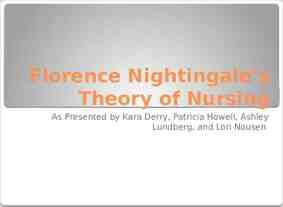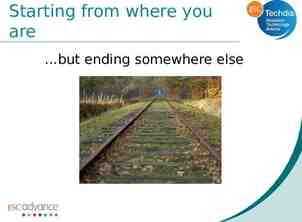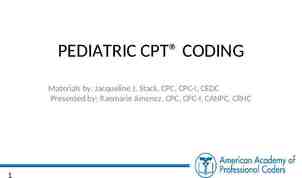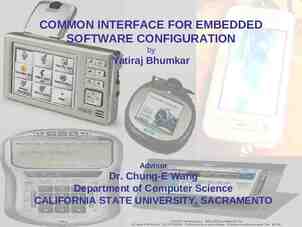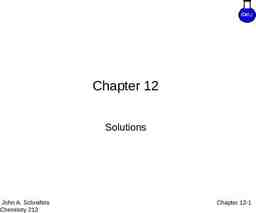Now Playing: Danny Elfman Film Composer and Musician
30 Slides1.72 MB

Now Playing: Danny Elfman Film Composer and Musician

Who is Danny Elfman? Writer and performer for musical theater troupe, “Mystic Knights of the Oingo Boingo” in the late 1970’s (founded by his brother, Richard). Lead vocalist and song writer for 80’s “New Wave” style band Oingo Boingo, later known as Boingo, which was more “alternative” in style, until band’s end in 1995. Celebrated Hollywood film

Daniel Robert Elfman: The Early th – Born May 29 , 1953Years to Blossom and Milton Elfman. – Grew up in Los Angeles California with his parents and older brother, Richard. – Self described “ordinary” kid who never received any formal musical

The Personal Life of Danny Elfman Married actress Bridget Fonda in 2003. Father to 3 children: – Lola – 1979 – Mali – 1984 Producer and Actress Danny produced the score for her film, “Do Not Disturb” – Oliver – 2005

Le Grand Magic Circus – After dropping out of high school and moving to Paris to live with his brother Richard, Danny taught himself to play his first instrument, the violin. – Began touring with Richard in the musical troupe, The Grand Magic Circus in the early 70’s, also writing compositions . – Continued to tour with The Grand Magic Circus after Richard returned to Los Angeles. – Returned to Los Angeles after

Mystic Knights of the Oingo Boingo Formed by Danny’s older brother Richard, inspired by his time performing with Le Grand Magic Circus in 1972. Danny became the Mystic Knights musical director in 1976 – Wrote many of the group’s songs, inspired by: Duke Ellington, Cab

Forbidden Zone (1980) A film produced by Richard Elfman. Danny’s first musical score. – Inspired by Nino Rota and Erik Satie Aside from composing the film’s music, Danny also acts in

Oingo Boingo (1980-1995)

Oingo Boingo As The Mystic Knights of the Oingo Boingo musical style changed, the group became smaller, and evolved into a new band with the shortened name, Oingo Boingo. The music of Oingo Boingo was considered as rock and “new wave” in style. The Band recorded several hit songs of the 80’s including: Dead Man’s

Pee Wee’s Big Adventure (1985) Elfman composed the score after being approached by Tim Burton and Paul Reubens. With inspiration from Nino Rota and Bernard Hermann, Danny composed the score with Steve Bartek as his arranger. Pee Wee’s Big Adventure is the first of over 80 films scored by Elfman, which includes the majority of Tim

The Unlikely Film Composer Danny continued to play with Oingo Boingo until 1995, while building a reputation as a film composer. Eventually became one of the most in-demand film composers in Hollywood. Has received numerous accolades and awards despite criticism and controversy surrounding some of

The Danny Elfman Process of Film Composition – The time frame in which the film score is to be completed is usually anywhere from a few weeks to nearly 3 months. – Danny begins by working with the director of each film in order to get ideas for the direction of the score. – Danny works with his orchestrator and conductor during the process, who help to interpret his ideas into the official score which is then performed by a live orchestra for the

Bruce, Ichabod, Alice, and the Music Box The Quirky Compositions Behind These Unforgettable Characters and sounds.

Batman: The Movie “The Batman Theme”

“The Batman Theme” (1989) Composed for Batman: The Movie as the main theme, as well as the leitmotif for Batman. Based on 6 particular notes that came to Elfman on a flight from London to the U.S., which are now synonymous with Batman, the character. Awards and Accolades Grammy award for Best Instrumental Composition.

The Legend of Sleepy Hollow “Main Title”

Sleepy Hollow “Main Theme”(1999) Composed as the main theme for the Tim Burton film, Sleepy Hollow. Assisted by former band mate Steve Bartek in the orchestration of the horror-like score. Contained two major contrasting character themes of the Horseman and Ichabod Crane. Awards: – Satellite Award for Best Score, Saturn

Alice in Wonderland “Alice’s Theme”

“Alice’s Theme” (2010) Composed for the Tim Burton film, Alice in Wonderland and considered by Elfman to be Alice’s “Hero Theme”. The only song on the score that contains lyrics, which were added at the last minute. Awards: – Nominated by the British Academy Awards for Best Film Music,

Oz: The Great and Powerful “Fireside Dance”

“Fireside Dance” (2013) Composed for the film, Oz: The Great and Powerful, directed by Sam Raimi. The piece consists of music box and waltz music, both of which were the first compositions in the entire score itself. Used throughout the film in various forms as part of the underscore. Oz: The Great and Powerful is

Interpreting the Unique Elfman Style of Musical Shorthand Understanding the Anatomy of an Elfman Composition (Musical Timing Guides)

“The Batman Theme” Introduction/Phase A: The first 6 notes play in both major and minor in a deep, grave tempo in a pianissimo dynamic, repeating twice. Phase B: The music transitions to a march with the crash of a cymbal at fortississimmo volume with many melodies and counter melodies as the march also increases in tempo to approx. allegro vivace. The dynamics lower to forte as the next phase begins. Phase C: The music slows back to the pace of the introduction into a modified version of phase A. Towards the end , the instruments begin to ascend with increased dissonance and volume . Most of this phase is in meno messo. Coda/End: The coda begins in a forississimo dynamic with quick and short bursts of notes played by strings and brass in homophony with a lot of marcitissimo. The

“Main Title” (Sleepy Hollow) Introduction/Phase A: The leitmotif for The Headless Horseman begins in the piece, in minor mode with much dissonance which is present throughout the phase. The deep sounds of brass and the organ take up the majority of the section., which also contains much fortississimmo dynamic. Phase B: A variation of a leitmotif for Ichabod Crane begins the phase which is a sharp contrast to the dynamics and chaotic sounds of the prior phase, in meno messo with whimsical sounds of chimes andwoodwinds along with soprano voices . Phase C: The letimotif for the Headless Horseman returns adding the same dissonance and dynamic as it did the first time. Phase D: The leitmotif for Ichabod returns with approximately the same format as before.

“Alice’s Theme” Introduction: The song begins with the string instruments, in a quick, allegro style tempo indicating urgency, as well as setting the tone for dissonance, which will play throughout the song adding to the tension. The chorus begins to sing. Verse 1: Begins with a cymbal crash There are strings, brass, and percussion along with flutes playing during it along with the voices of the chorus. Emphasis and cadence is placed on the last line of the verse. Verse 2: The strings come into the foreground while the brass begin ascending in a bass tone the pitch and dynamics increase as the voices of the chorus sing the verse. Verse 3: The texture increases. The chorus begins singing a different melody than the prior two verses, picking up tempo quite a bit and changing form. Bridge: The middle of the song contains a “gallup” style tempo with the percussion dominating, while the strings are still present. 4th Verse: The chorus begins singing another verse much faster in a vivace tempo and higher pitch. 5th verse: The melody of the first verse contains with the brass at a near fortississimo dynamic. The chorus repeats the final words of the prior verses as they sing the last verse.

“Fireside Dance” Introduction/Phase: The “music box” begins playing in a triplemeter, which is the narrative music of Oz. It is piano dynamic, at an andante or moderato tempo. A second melody is introduced at a slightly different tempo and an increased pitch. Both melodies are as other subjects join in, in a repetitive arch contour. Phase B: The timbre changes. The violins begin to play in meno mosso and an ascending contour while the elements making up the music box descend in a minor mode twice. The 2nd music melody joins in harmony and homophonic texture. The faint sounds of the chorus begin to appear, as well as a few of the brass and woodwinds. Phase C: The timbre changes again as another instrument joins in and contrasts with the harp, strings, and music box, all of which remain meno mosso. The chorus increases its presence and adds just a little bit of dissonance. The dynamics increase to mezzo forte. Coda/End: The timbre changes again. The strings continue in

Biographical Works Cited: BMI. Top Film, TV, Cable Composers honored at BMI's Annual Film/TV Awards. 14 May 2002. 8 September 2013 http://www.bmi.com/news/entry/233117 . Elfman, Danny. Battling Our Greatest Fear. 30 October 2008. 6 September 2013 http://www.huffingtonpost.com/danny-elfman/battling-our-greatestfea b 139246.html . Elfman, Danny. Danny Elfman Rick Clark. 1 May 2001. Elfman, Danny. Interview: Danny Elfman John Braheny. Los Angeles Showcase Musepaper, 1990. Elfman, Richard. Oingo Boingo: The Complete History. 11 November 2011. 7 September 2013 http://www.buzzinemusic.com/article/musicoingo-boingo-05072009 . Elfman, Richard. The Man Behind "Forbidden Zone" Rip Rense. Herald Examiner, 18 August 1982. IMDB. Awards for Danny Elfman. n.d. 7 September 2013 http://www.imdb.com/name/nm0000384/awards . Silber, Frederick. "Danny Elfman: Wunderkind of Filmmusic." Fanfare 1989.

Composition History Works Cited: Boucher, Geoff. Danny Elfman Searches for the Sound of "Wonderland". 4 February 2010. 8 September 2013 http://herocomplex.latimes.com/uncategorized/danny-elfmansearches-for-the-sound-of-wonderland/ . Elfman, Danny. Danny Elfman Rick Clark. 1 May 2001. —. Danny Elfman - Composer Oz the Great and Powerful. n.d. 8 September 2013 http://www.youtube.com/watch?v AD6c2wZqSA . Faraci, Devin. Elfman Vs. Raimi: Round II. 13 October 2005. 8 September 2013 http://www.chud.com/4718/elfman-vs-raimiround-ii/ . Filmtracks.com. Alice in Wonderland. 10 June 2011. 7 September 2013 http://www.filmtracks.com/titles/alice wonderland.html . —. Batman. 2 June 2011. 8 september 2013 http://www.filmtracks.com/titles/batman.html . fMcIntyre, Gina. "The Hero Complex Interview: Danny Elfman." The New York Times 19 November 2010.

“It often feels like a tremendous amount of work is required to get an idea moving forward, like pushing a train uphill. But at a certain point, the thing takes on its own momentum, and takes unexpected turns. So it's that feeling of holding on, rather than pushing it, that is the most exciting thing. It's that need to occasionally bounce off the walls, letting anything happen for any reason, and having nothing to guide you that is the joy.”


